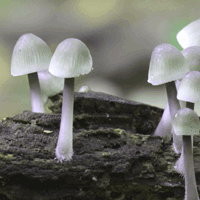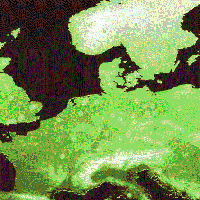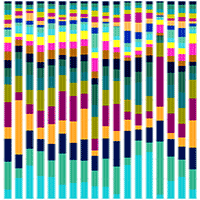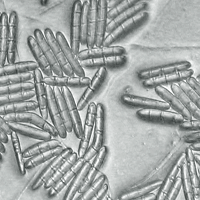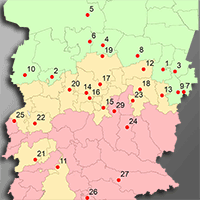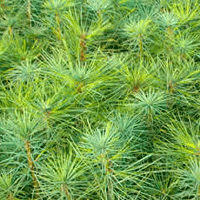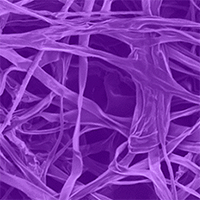We examined the concordance between vascular plants and macrofungi (grouped into trophic groups) in Mediterranean forest habitats (central Italy). Our goal was to test how consistently plant and fungi groups classify plots in a broadleaf deciduous forest dominated by Quercus cerris. Our hypothesis was that groups of plants can be used as surrogates for the classification of macrofungal communities. The test of concordance comprised two steps: 1) the plant species data sets were subjected to cluster analysis, to obtain three classifications based on presence of all plants, presence and frequency of only woody species; 2) Multiple Response Permutation Procedures (MRPP) was used to test the performance of each plant classification applied to the fungi data sets. The sample scores along the first PCA axis was used to investigate the relationships between compositional patterns. In the concordance analysis, the classification of only woody plants provided better results than the classification obtained with herbaceous and woody plants together. Cross-tests gave the best results when the “woody plants” classification was applied to ectomycorrhizal fungi (EMF) and, to a certain extent, to humicolous saprotrophs (Sh). The ordination analysis indicated that the frequency of woody plants follows a similar spatial distribution to EMF and Sh fungal groups and is therefore expected to discriminate the same environmental gradients. Many EMF exhibit preferences for few (one or two) hosts. Significant associations were found among a greater number of EMF and woody plant species. Woody plants such as Sorbus domestica and Prunus spinosa appear to be associated with many EMF. The combination of a high frequency of Fraxinus oxycarpa and Quercus petraea seems to promote distinct assemblages of EMF and Sh fungi. Then, characteristic assemblages of fungi were found in association with certain tree and shrub combinations.
Keywords
, , , , ,
Citation
Landi M, Salerni E, Ambrosio E, D’Aguanno M, Nucci A, Saveri C, Perini C, Angiolini C (2015). Concordance between vascular plant and macrofungal community composition in broadleaf deciduous forests in central Italy. iForest 8: 279-286. - doi: 10.3832/ifor1199-008
Academic Editor
Alberto Santini
Paper history
Received: Dec 10, 2013
Accepted: May 15, 2014
First online: Aug 22, 2014
Publication Date: Jun 01, 2015
Publication Time: 3.30 months
© SISEF - The Italian Society of Silviculture and Forest Ecology 2015
Open Access
This article is distributed under the terms of the Creative Commons Attribution-Non Commercial 4.0 International (https://creativecommons.org/licenses/by-nc/4.0/), which permits unrestricted use, distribution, and reproduction in any medium, provided you give appropriate credit to the original author(s) and the source, provide a link to the Creative Commons license, and indicate if changes were made.

Breakdown by View Type
(Waiting for server response...)
Article Usage
Total Article Views: 53448
(from publication date up to now)
Breakdown by View Type
HTML Page Views: 43684
Abstract Page Views: 3514
PDF Downloads: 4620
Citation/Reference Downloads: 48
XML Downloads: 1582
Web Metrics
Days since publication: 4149
Overall contacts: 53448
Avg. contacts per week: 90.17
Article Citations
Article citations are based on data periodically collected from the Clarivate Web of Science web site
(last update: Mar 2025)
Total number of cites (since 2015): 15
Average cites per year: 1.36
Publication Metrics
by Dimensions ©
Articles citing this article
List of the papers citing this article based on CrossRef Cited-by.
(1)
Arnolds E (1981)Ecology and coenology of macrofungi in grasslands and moist heathlands in Drenthe, the Netherlands. Part 1. Introduction and Synecology. Bibliotheca Mycologica 83: 1-410.
Gscholar
(2)
Arnolds E, Kuyper TW, Noordeloos ME (1995)Overzicht van de paddestoelen in Nederland [Overview of mushrooms in Netherlands]. Nederlandse Mycologische Vereniging, Wijster, The Netherlands, pp. 872. [in Dutch]
Gscholar
(3)
Balmford A, Jayasuriya AH, Green MJB (1996)Using higher-taxon richness as a surrogate for species richness. 2. Local applications. Proceedings of the Royal Society B 263: 1571-1575.
CrossRef |
Gscholar
(4)
Bencivenga M, Calandra R, Giovanotti E, Russi L (1990)Aspetti pedologici e vegetazionali delle tartufaie di alcune specie di “tartufi minori” [Soil and vegetation aspects of truffle grounds for some species of “minor truffles”]. Annali della Facoltà di Agraria 50: 7-45. [in Italian]
Gscholar
(5)
Berg B, McClaugherty C (2007)Plant litter: decomposition, humus formation, carbon sequestration (2nd edn). Springer-Verlag, Heidelberg, Berlin, Germany, pp. 338.
Gscholar
(6)
Berglund H, Jonsson BG (2001)Predictability of plant and fungal species richness of old-growth boreal forest islands. Journal of Vegetation Science 12: 857-866.
CrossRef |
Gscholar
(7)
Biondini ME, Mielke PW, Berry KJ (1988)Data-dependent permutation techniques for the analysis of ecological data. Vegetatio 75: 161-168.
Online |
Gscholar
(8)
Brussaard L, Kuyper TW, De Goede RGM (2001)On the relationships between nematodes, mycorrhizal fungi and plants: functional composition of species and plant performance. Plant and Soil 232: 155-165.
CrossRef |
Gscholar
(9)
Buée M, Maurice JP, Zeller B, Andrianarisoa S, Ranger J, Courtecuisse R, Marçais B, Le Tacon F (2011)Influence of tree species on richness and diversity of epigeous fungal communities in a French temperate forest stand. Fungal Ecology 4: 22-31.
CrossRef |
Gscholar
(10)
Chevalier G, Desmas C, Frochot H, Riousset L (1978)L’espèce
Tuber aestivum Vitt. II. Ecologie [The species
Tuber aestivum Vitt. II. Ecology]. Mushroom Science 10 (1): 977-993. [in French]
Gscholar
(11)
Chiarucci A, D’Auria F, De Dominicis V, Laganà A, Perini C, Salerni E (2005)Using vascular plants as a surrogate taxon to maximize fungal species richness in reserve design. Conservation Biology 19: 1644-1652.
CrossRef |
Gscholar
(12)
Conti F, Abbate G, Alessandrini A, Blasi C (2005)An annotated checklist of the Italian vascular flora. Palombi Editore, Rome, Italy, pp. 420.
Gscholar
(13)
Cripps CL (2004)Fungi in forest ecosystems: systematics, diversity and ecology. The New York Botanical Garden, New York, USA, pp. 363.
Gscholar
(14)
Deacon JW, Fleming LV (1992)Interactions of ectomycorrhizal fungi. In: “Mycorrhizal Functioning, an Integrative Plant-Fungal Process” (Allen MF ed). Chapman and Hall, New York, USA, pp. 249-300.
Gscholar
(15)
De Bellis T, Kernaghan G, Bradley R, Widden P (2006)Relationships between stand composition and ectomycorrhizal community structure in boreal mixed-wood forests. Microbial Ecology 52: 114-126.
CrossRef |
Gscholar
(16)
Dickie IA, Moyersoen B (2008)Towards a global view of ectomycorrhizal ecology. New Phytologist 180: 263-265.
CrossRef |
Gscholar
(17)
Dighton J, Poskitt JM, Howard DM (1986)Changes in occurrence of basidiomycete fruit bodies during forest stand development with specific reference to mycorrhizal species. Transactions of the British Mycological Society 87: 163-171.
CrossRef |
Gscholar
(18)
Ferris R, Peace AJ, Newton AC (2000)Macrofungal communities of lowland Scots pine (
Pinus sylvestris L.) and Norway spruce (
Picea abies (L.) Karsten.) plantations in England: relationships with site factors and stand structure. Forest Ecology and Management 131: 255-267.
CrossRef |
Gscholar
(19)
Gaston KJ (2000)Global patterns in biodiversity. Nature 405: 220-227.
CrossRef |
Gscholar
(20)
Hawksworth DL (1991)The fungal dimension of biodiversity: magnitude, significance and conservation. Mycological Research 95: 641-655.
CrossRef |
Gscholar
(21)
Hawksworth DL (2001)The magnitude of fungal diversity: the 1.5 million species estimate revised. Mycological Research 105: 1422-1432.
CrossRef |
Gscholar
(22)
Heino J, Mykrä H (2006)Assessing physical surrogates for biodiversity: do tributary and stream type classifications reflect macroinvertebrate assemblage diversity in running waters? Biological Conservation 129: 418-426.
CrossRef |
Gscholar
(23)
Hill MO, Gauch HG (1980)Detrended correspondence analysis, an improved ordination technique. Vegetatio 42: 47-58.
CrossRef |
Gscholar
(24)
Humphrey JW, Newton AC, Peace AJ, Holden E (2000)The importance of conifer plantations in northern Britain as a habitat for native fungi. Biological Conservation 96: 241-252.
CrossRef |
Gscholar
(25)
Kernaghan G, Widden P, Bergeron Y, Légaré S, Paré D (2003)Biotic and abiotic factors affecting ectomycorrhizal diversity in boreal mixed-woods. Oikos 102: 497-504.
CrossRef |
Gscholar
(26)
Kirk P, Cannon PF, Minter DW, Stalpers JA (2008)Ainsworth & Bisby’s Dictionary of the Fungi (10th edn). CAB International, Wallingford, UK, pp. 771.
Gscholar
(27)
Landi M, Piazzini S, Nucci A, Saveri C, Angiolini C (2012)Can macrophytes be a surrogate for amphibians and physico-chemical features in pond classifications? Aquatic Botany 101: 1-7.
CrossRef |
Gscholar
(28)
Leps J, Smilauer P (2003)Multivariate analysis of ecological data using CANOCO. Cambridge University Press, Cambridge, UK, pp. 282.
Gscholar
(29)
Lodge DJ, Ammirati JF, O’Dell TE, Mueller GM (2004)Collecting and describing Macrofungi. In: “Biodiversity of Fungi, Inventory and Monitoring Methods” (Müller GM, Bills GF, Foster MS eds). Elsevier Academic Press, Oxford, UK, pp. 129-158.
Gscholar
(30)
Magurran AE (2004)Measuring biological diversity. Blackwell Publishing company, Oxford, UK, pp. 256.
Gscholar
(31)
Mason PA, Last FT, Pelham J, Ingleby K (1982)Ecology of some fungi associated with an ageing stand of birches (
Betula pendula and
Betula pubescens). Forest Ecology and Management 4: 19-39.
CrossRef |
Gscholar
(32)
McCune B, Grace JB (2002)Analysis of ecological communities. MJM Software Design, Gleneden Beach, OR, USA, pp. 300.
Gscholar
(33)
McCune B, Mefford MJ (2011)PC-ORD: multivariate analysis of ecological data (v. 6.0). MJM Software Design, Gleneden Beach, OR, USA, pp. 28.
Gscholar
(34)
McDonald KR, Pennell J, Frank JL, Southworth D (2010)Ectomycorrhizas of
Cercocarpus ledifolius (Rosaceae). American Journal of Botany 97: 1867-1872.
CrossRef |
Gscholar
(35)
McMullan-Fisher SJM, Kirkpatrick JB, May TW, Pharo EJ (2009)Surrogates for macrofungi and mosses in reservation planning. Conservation Biology 24: 730-736.
CrossRef |
Gscholar
(36)
Molina RJ, Massicotte H, Trappe JM (1992)Specificity phenomena in mycorrhizal symbioses: community-ecological consequences and practical implications. In: “Mycorrhizal Functioning, an Integrative Plant-fungal Process” (Allen MF ed). Chapman and Hall, New York, USA, pp. 357-423.
Gscholar
(37)
Mortiz C, Richardson KS, Ferrier S, Monteith GB, Stanisic J, Williams S, Whiffin T (2001)Biogeographical concordance and efficiency of taxon indicators for establishing conservation priority in a tropical rainforest biota. Proceedings of the Royal Society B 268: 1875-1881.
CrossRef |
Gscholar
(38)
Murphy DD, Weiland PS, Cummins KW (2011)A critical assessment of the use of surrogate species in conservation planning in the Sacramento-San Joaquin Delta, California (USA). Conservation Biology 25: 873-878.
CrossRef |
Gscholar
(39)
O’Hanlon R, Harrington TJ (2012)Macrofungal diversity and ecology in four Irish forest types. Fungal Ecology 5: 499-508.
CrossRef |
Gscholar
(40)
Onofri S, Bernicchia A, Filipello Marchisio V, Padovan F, Perini C, Ripa C, Salerni E, Savino E, Venturella G, Vizzini A, Zotti M, Zucconi L (2005)Checklist dei funghi italiani Basidiomycetes [Checklist of Italian fungi Basidiomycota]. Carlo Delfino Editore, Sassari, Italy, pp. 380.
Gscholar
(41)
Öster M (2008)Low congruence between the diversity of Waxcap (
Hygrocybe spp.) fungi and vascular plants in semi-natural grasslands. Basic and Applied Ecology 9: 514-522.
CrossRef |
Gscholar
(42)
Paavola R, Muotka T, Virtanen R, Heino J, Kreivi P (2003)Are biological classifications of headwater streams concordant across multiple taxonomic groups? Freshwater Biology 48: 1912-1923.
CrossRef |
Gscholar
(43)
Packham JM, May TW, Brown MJ, Wardlaw TJ, Mills AK (2002)Macrofungal diversity and community ecology in mature and regrowth wet eucalypt forest in Tasmania: a multivariate study. Austral Ecology 27: 148-161.
CrossRef |
Gscholar
(44)
Paszkowski CA, Tonn WA (2000)Community concordance between the fish and aquatic birds of lakes in northern Alberta, Canada: the relative importance of environmental and biotic factors. Freshwater Biology 43: 421-437.
CrossRef |
Gscholar
(45)
Pharo EJ, Beattie AJ, Binns D (1999)Vascular plant diversity as a surrogate for bryophyte and lichen diversity. Conservation Biology 13: 282-292.
CrossRef |
Gscholar
(46)
Qian H, Ricklefs RE (2008)Global concordance in diversity patterns of vascular plants and terrestrial vertebrates. Ecology Letters 11: 547-553.
CrossRef |
Gscholar
(47)
Roberts C, Ceska O, Kroeger P, Kendrick B (2004)Macrofungi from six habitats over five years in Clayoquot Sound, Vancouver Island. Canadian Journal of Botany 82: 1518-1538.
CrossRef |
Gscholar
(48)
Ryti RT (1992)Effect of the focal taxon on the selection the nature reserves. Ecological Applications 2: 404-410.
CrossRef |
Gscholar
(49)
Sætersdal M, Gjerde I, Blom HH, Ihlen PG, Myrseth EW, Pommeresche R, Skartveit J, Solhøy T, Aas O (2003)Vascular plants as a surrogate species group in complementary site selection for bryophytes, macrolichens, spiders, carabids, staphylinids, snails, and wood living polypore fungi in a northern forest. Biological Conservation 115: 21-31.
CrossRef |
Gscholar
(50)
Salerni E, Laganà A, De Dominicis V (2001)Mycocoenological studies in deciduous oak woods of central-southern Tuscany (Italy). Cryptogamie Mycologie 22: 35-55.
CrossRef |
Gscholar
(51)
Salerni E, Perini C (2007)Mycodiversity of nature reserves in central Italy. Acta Mycologica 42: 5-19.
CrossRef |
Gscholar
(52)
Salerni E, Baglioni F, Mazzei T, Gardin L, Ciabatti F, Leonardi P, Vesprini J, Perini C (2010)Efectos de las diversas técnicas culturales sobre la producción de
Tuber aestivum Vitt. y de
Tuber melanosporum Vitt. en dos plantaciones experimentales en Italia central [Effects of different cultural techniques on the production of
Tuber aestivum Vitt. and
Tuber melanosporum Vitt. in two experimental plantations in central Italy]. ZIZAK 7: 47-62. [in Spanish]
Gscholar
(53)
Sanders TGM, Pitman R, Broadmeadow MSJ (2014)Species-specific climate response of oaks (
Quercus spp.) under identical environmental conditions. iForest 7: 61-69.
CrossRef |
Gscholar
(54)
Santi E, Maccherini S, Rocchini D, Bonini I, Brunialti G, Favilli L, Perini C, Pezzo F, Piazzino S, Rota E, Salerni E, Chiarucci A (2010)Simple to sample: vascular plants as surrogate group in a nature reserve. Journal for Nature Conservation 18: 2-11.
CrossRef |
Gscholar
(55)
Santos-Silva C, Gonçalves A, Louro R (2011)Canopy cover influence on macrofungal richness and sporocarp production in montado ecosystems. Agroforestry Systems 82: 149-159.
CrossRef |
Gscholar
(56)
Schmit JP, Mueller GM, Leacock PR, Mata JL, Wu QX, Huang YQ (2005)Assessment of tree species richness as a surrogate for macrofungal species richness. Biological Conservation 121: 99-100.
CrossRef |
Gscholar
(57)
Similä M, Kouki J, Mönkkönen M, Sippola AL, Huhta E (2006)Co-variation and indicators of species diversity: can richness of forest-dwelling species be predicted in northern boreal forests? Ecological Indicators 6: 686-700.
CrossRef |
Gscholar
(58)
Su JC, Debinski DM, Jakubauskas ME, Kindscher K (2004)Beyond species richness: Community similarity as a measure of cross-taxon congruence for coarse-filter conservation. Conservation Biology 18: 167-173.
CrossRef |
Gscholar
(59)
Temunović M, Franjić J, Satovic Z, Grgurev M, Frascaria-Lacoste N, Fernández-Manjarrés JF (2012)Environmental heterogeneity explains the genetic structure of Continental and Mediterranean populations of
Fraxinus angustifolia Vahl. PLoS ONE 7 (8): e42764.
CrossRef |
Gscholar
(60)
ter Braak CJF, Šmilauer P (2002)CANOCO reference manual and CanoDraw for Windows user’s guide: software for canonical community ordination. Microcomputer Power 4.5, Ithaca, New York, USA, pp. 500.
Online |
Gscholar
(61)
Tóth BB, Barta Z (2010)Ecological studies of ectomycorrhizal fungi: an analysis of survey methods. Fungal Diversity 45: 3-19.
CrossRef |
Gscholar
(62)
Tyler G (1992)Tree species affinity of decomposer and ectomycorrhizal macrofungi in beech (
Fagus sylvatica L.), oak (
Quercus robur L.) and hornbeam (
Carpinus betulus L.) forests. Forest Ecology and Management 47: 269-284.
CrossRef |
Gscholar
(63)
Twieg BD, Durall DM, Simard SW, Jones MD (2009)Influence of soil nutrients on ectomycorrhizal communities in a chronosequence of mixed temperate forests. Mycorrhiza 19: 305-316.
CrossRef |
Gscholar
(64)
Virolainen KM, Ahlroth P, Hyvärinen E, Korkeamäki E, Mattila J, Päivinen J, Rintala T, Suomi T, Suhonen J (2000)Hot spots, indicator taxa, complementarity and optimal networks of taiga. Proceedings of the Royal Society B 267: 1143-1147.
CrossRef |
Gscholar
(65)
Zimmerman GM, Goetz H, Mielke PV (1985)Use of an improved statistical method for group comparisons to study effects of prairie fire. Ecology 66: 606-611.
CrossRef |
Gscholar
(66)
Whitfield J (2007)Fungal roles in soil ecology: underground networking. Nature 449: 136-138.
CrossRef |
Gscholar
(67)
Young TP (2000)Restoration ecology and conservation biology. Biological Conservation 92: 73-83.
CrossRef |
Gscholar
